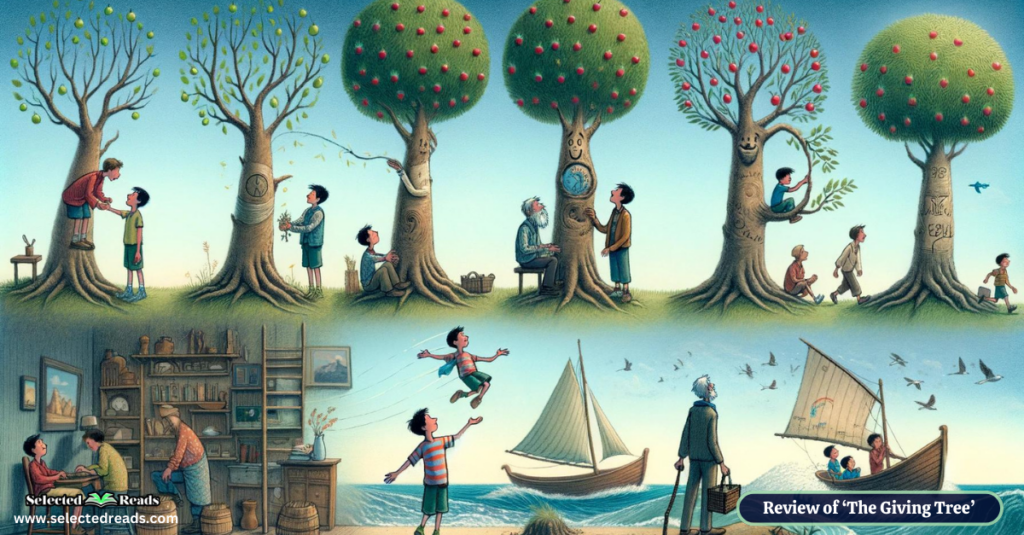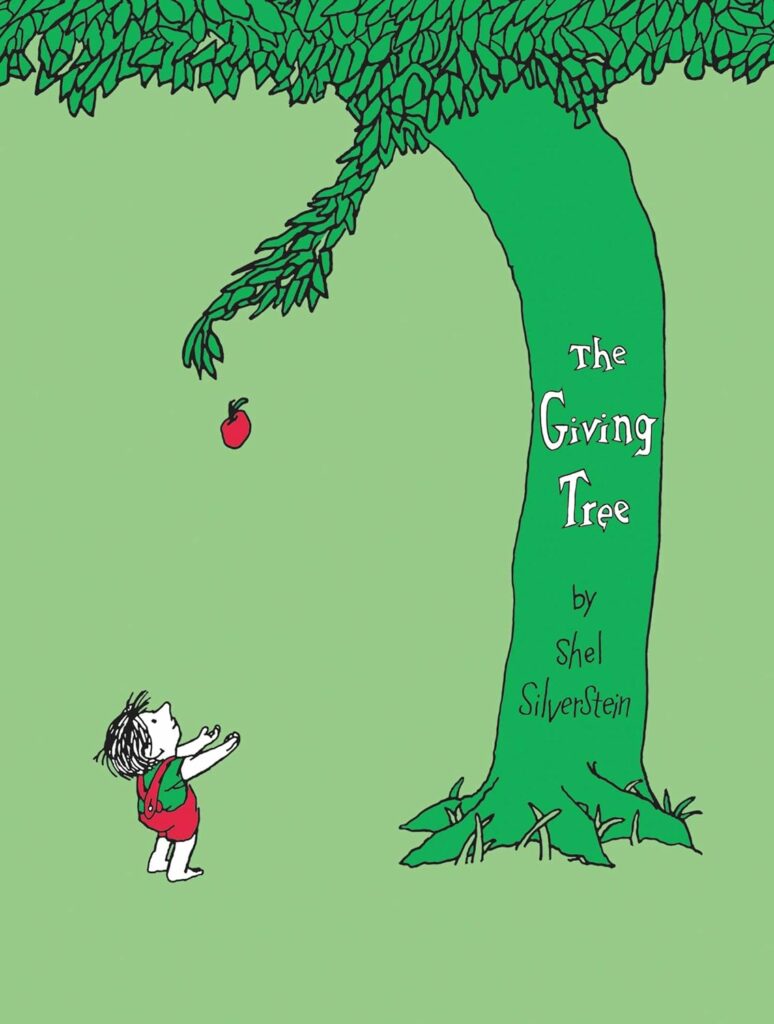“The Giving Tree” by Shel Silverstein, a cherished classic that transcends the boundaries of children’s literature to touch the hearts of readers of all ages, is the focus of our post today. The purpose is to provide you with a thorough insight into the narrative and themes of “The Giving Tree” without venturing into spoiler territory.
My discussion will proceed as follows: I’ll start with a comprehensive summary of the story, highlighting the relationship between the main characters—the tree and the boy—as it evolves over time. Next, we will delve deeper into the characteristics and roles of these two central figures. To conclude, I’ll present a selection of thought-provoking book club questions designed to stimulate discussion and reflection on the deeper meanings and interpretations of this timeless story.
Related: Wonder Book Summary
The Giving Tree Summary
“The Giving Tree” by Shel Silverstein is a picture book that tells the evolving story of a relationship between a boy and a tree throughout the stages of the boy’s life, from childhood to old age. The narrative begins with a young boy who enjoys playing with the tree, climbing its trunk, swinging from its branches, and eating its apples. During this time, the tree is happy to provide the boy with joy and the fruits of its branches.
As the boy grows older, his visits become less frequent, and his needs change. When he returns as a teenager, he asks the tree for money. The tree suggests that he sell her apples, which he does, and the tree is happy to have been able to help. Later, as a young man, the boy desires a house, and the tree offers her branches so that he can build one. Once again, the tree is happy to provide for the boy’s needs.
Photo: Amazon
Years pass, and the boy returns as a middle-aged man. This time, he wants a boat to sail away and find peace. The tree, now only a trunk, offers herself for the boy to carve out a boat. He does so and sails away, leaving the tree as just a stump. Finally, the boy returns as an old man, tired and seeking a quiet place to sit and rest. The tree, thinking she has nothing left to give, offers her stump for the boy, now an old man, to sit on. The boy accepts, and the tree is happy once again, able to provide the boy with comfort in his old age.
Through its simple yet profound narrative, “The Giving Tree” explores themes of unconditional love, sacrifice, and the changing nature of relationships over time. The tree’s constant giving, until it has nothing left but a stump, serves as a poignant metaphor for selfless love and generosity. In contrast, the boy’s evolving needs and requests reflect the human experience of growth, desire, and the eventual realization of what is truly important in life. Shel Silverstein’s sparse text and illustrations deliver a powerful emotional impact, making “The Giving Tree” a timeless story cherished by readers of all ages.
The Giving Tree Characters
In “The Giving Tree” by Shel Silverstein, the story revolves around two central characters, each serving a symbolic role that explores themes of love, sacrifice, and the passage of time. These characters are:
- The Tree: The tree is a female entity that embodies unconditional love and selflessness. From the story’s outset, the tree finds joy in providing for the boy, whether it’s offering shade, apples, branches, or even her trunk. As the boy’s needs evolve over time, the tree continues to give all that she has, piece by piece, until she is reduced to nothing but a stump. Despite her sacrifices, the tree remains happy as long as she can provide some form of comfort or aid to the boy. The tree’s character is a powerful metaphor for selfless love and generosity, illustrating the joy found in giving to others without expecting anything in return.
- The Boy: The boy represents the human experience, marked by growth, changing desires, and the often one-sided nature of taking. As a child, the boy enjoys simple pleasures like playing in and around the tree. However, as he ages, his visits become less frequent, and his requests more significant, reflecting his changing priorities and increasing demands. The boy’s journey from innocent childhood through the complexities of adulthood and into reflective old age mirrors the typical human arc of growth and realization. His relationship with the tree evolves from one of mutual joy to one where he primarily takes, only to return in old age with a newfound appreciation for the simplicity and comfort the tree provides.
The Giving Tree Book Club Questions
Here are some questions to help guide your discussion:
- Interpretations of the Relationship: How do you interpret the relationship between the tree and the boy? Do you see it as purely loving and selfless, or do you believe there are elements of codependency or selfishness involved?
- The Theme of Giving: The tree gives everything it has to the boy until it is left with nothing but a stump. What does this say about the nature of giving and sacrifice? Is there a point where giving becomes self-destructive?
- The Boy’s Actions: How do you perceive the boy’s actions throughout the book? Are his requests of the tree reasonable or selfish? How does his relationship with the tree change as he grows older?
- Symbolism of the Tree: The tree can be seen as a symbol for various things such as parental love, nature, or even God. What does the tree represent for you? How does this interpretation affect your understanding of the story?
- The Ending: How did you feel about the ending of the story? Some readers find it deeply sad, while others see a message of unconditional love and happiness in simplicity. What was your emotional response?
- Message to Children vs. Adults: “The Giving Tree” is often categorized as a children’s book, but its themes resonate with adults as well. Do you think the message of the book differs for children and adults? If so, how?
- Shel Silverstein’s Presentation: The story is told through both text and illustration, in Silverstein’s signature minimalist style. How do the illustrations contribute to the story’s impact? Do you think the story would feel different without them?
- Environmental Interpretation: Some readers interpret the book as a parable about the environment and human consumption. Did you see any environmental themes while reading? How does this perspective alter the story’s message?
- Lessons Learned: What do you think are the most important lessons from “The Giving Tree”? Are there any lessons you disagree with or found problematic?
- Alternative Endings: If you could give “The Giving Tree” an alternative ending, what would it be? How would it change the overall message of the book?
Related: Best 80’s Children’s Books
Final thoughts
To conclude, I hope that you have found this short review of “The Giving Tree” by Shel Silverstein interesting and thought-provoking. This timeless tale, while simple in its narrative, delves deep into the essence of giving, love, and the complexities of human relationships through the story of a boy and his lifelong friendship with a tree. If you have not already read it, I highly recommend immersing yourself in this classic.









